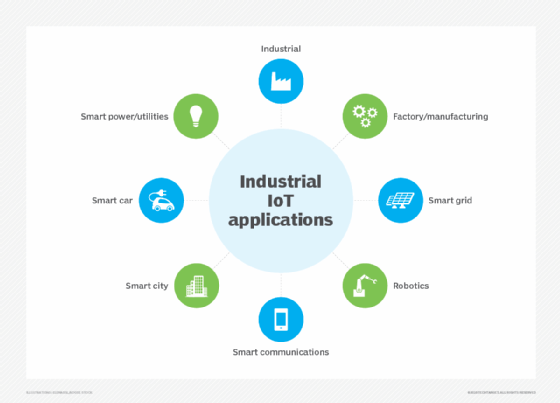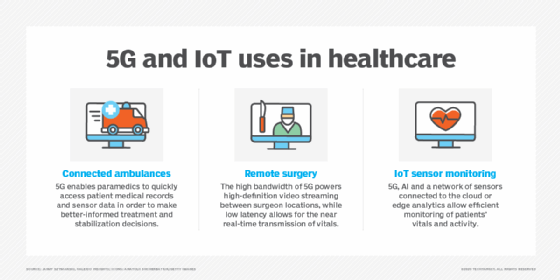
Elnur - stock.adobe.com
Discover realistic 5G IoT use cases that add value
When looking to apply 5G in IoT use cases, IoT leaders must think more about the combination of new edge devices and applications than about the new version of wireless.
IoT leaders who want to deploy 5G networks for IoT must define use cases that couldn't be realized as readily with 4G and add enough service revenue potential.
Adoption of 5G isn't dependent on what organizations can do with it, but rather what they can't do without it. Depending on the value of that something and whether or not there are barriers to justifying near-term ROI, 5G presents numerous opportunities and benefits.
5G as a cellular service offers what 4G does but with higher bandwidth and lower latency. The most complex issue in 5G isn't radio networks or core architecture, but 5G IoT use cases.
The 5G IoT use cases that will advance wireless technology are those that can combine new edge devices and applications quickly. Most of the popular examples of 5G IoT use cases -- such as augmented reality (AR), holographic vision and autonomous vehicles -- have kernels of true value but have been generalized to the point where they're unrealistic or unproductive. What's left when tech experts pare down these use cases is what's critical for 5G deployment.
5G improves on general wireless connectivity use cases
The primary cross-industry use case for 5G is capacity multiplication within key service areas. 5G offers greater capacity per cell and a simpler microcell architecture for distribution of wireless connections. As a result, it can deliver 10 to 100 times the aggregate capacity for a given geographic area. Broadband demand varies considerably with the population of users and the use of cellular service. 5G can be the difference between supplying what customers need and creating shortages that result in subscriber churn. Capacity multiplication is the guaranteed 5G use case, and while it's not very exciting, it's what's behind current initiatives. Improved versions of what mobile networks already offer will give organizations enough incentive to deploy 5G.

A second cross-industry use case with high credibility is distributed factory or warehouse control. Industrial automation in a confined space is often best supported by either wired sensors or controllers or using a short-haul wireless protocol, such as Wi-Fi. For more distributed facilities, this approach requires setting up networks for each area and coordinating the data flows into and out of the facilities. If there are elements -- such as automated goods or parts carriers -- that have to move between facilities, the control hand-offs can be awkward. 5G provides a means of supporting process control and the movement of goods throughout a large distributed facility. The high capacity of 5G ensures that concentrations of automated processes won't overload the network.
Practical applications in transportation, utilities and healthcare
In the transportation industry, the most credible use case is connected vehicle telemetry. Often people conflate this with self-driving car applications. There are very few vehicles equipped to self-drive, but no significant 5G opportunity can be created until there's a standard way of supporting any drive-assist technology via cellular connection. That means early applications should focus on vehicle telemetry, including driver's view camera, a view of the driver, and view of passengers and goods. These telemetry applications can be retrofitted onto existing vehicles, so practical near-term deployment of the equipment is realistic.

Critical facilities monitoring presents the most credible 5G IoT use case for public utilities. Many utilities already use IoT sensor technology to monitor conditions in critical facilities, including sensors for temperature, humidity, access and intrusion, pressure, voltage, and the state of any control dials or valves. 5G has the ability to support higher-density applications because of its greater cell bandwidth, but it can also support video monitoring in real time or when triggered by a sensor condition. The combination can alert central control specialists to work with local personnel to overcome a problem because all parties can see the issue and what local personnel are doing.
The medical industry has many potential 5G IoT use cases, but the one with the greatest realistic potential is high-touch telemedicine, such as remote or robotic surgery, although those examples have narrower application potential. There are many areas, even within an industrialized country, where clinical resources are largely unavailable. In the event of a natural disaster, local facilities could be damaged or overloaded. High-touch telemedicine presumes that a clinical agent could be deployed in these situations and linked back to a central medical facility with highly qualified personnel available. People with basic first-aid or healthcare training, or even laypeople if necessary, would then work under remote supervision to provide medical treatment.

This is likely the most promising of the longer-term use cases for several reasons. The world has already experienced situations where this kind of facility would be valuable, even essential. The recent COVID-19 pandemic is one example. The higher 5G capacity available would allow a clinical agent device to support multiple diagnostic and treatment experiences from the same point at the same time, making it more useful and easier to justify. Individuals with chronic medical conditions that require home monitoring and, in emergencies, home intervention could be provided with a lightweight version of the agent, improving care for a group difficult to manage in traditional medical facilities because of the cost.
Healthcare technology organizations may also use high-touch telemedicine as a model for immersive projection technology. An agent device with high-capacity 5G capability could use immersive technology, including AR and holographic or 3D video, to project a specialist into a remote situation where they could either guide robotic elements or local agents to perform complex tasks. This is the foundation for many of the classic 5G IoT use cases that either don't have an immediate value to justify deployment or have too high a near-term adoption cost.






